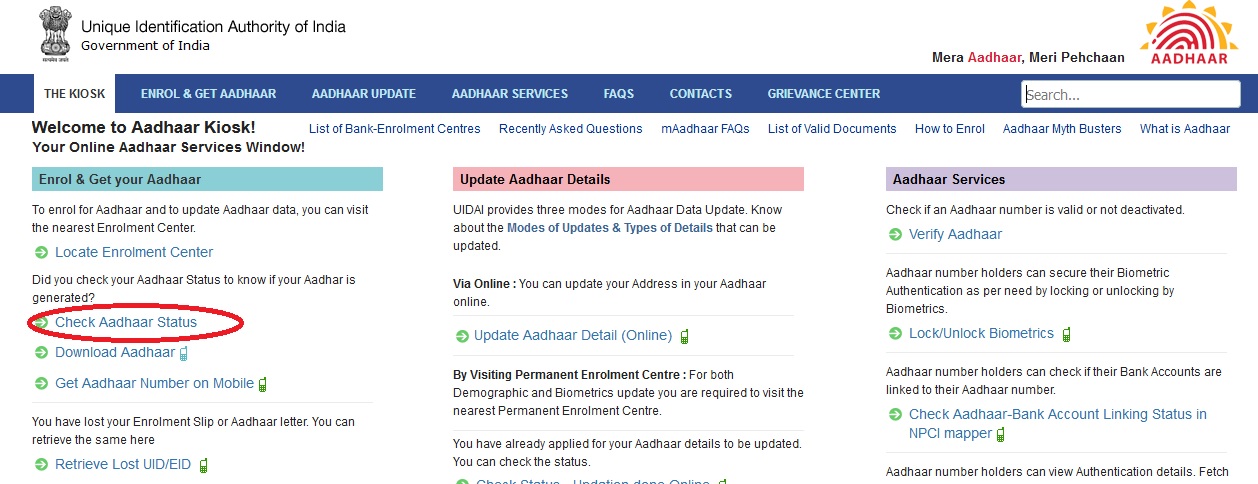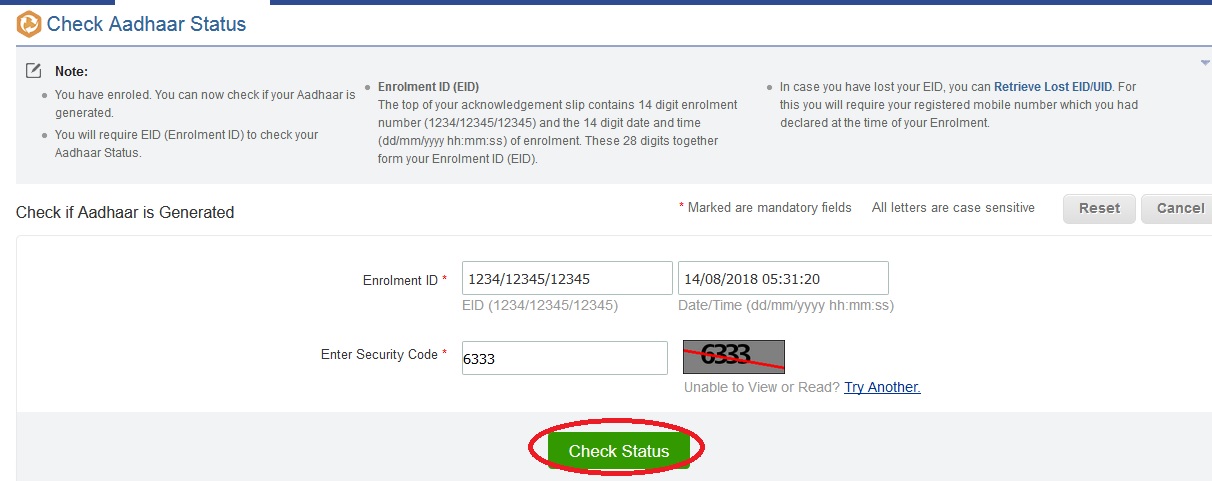Organisation : Unique Identification Authority of India
Facility : Aadhaar Enrolment Process
Home Page : https://uidai.gov.in/en/
UIDAI Aadhaar Enrolment Process
What is the process that will be followed to issue Aadhaar? :
A resident will have to go to an enrolling agency along with Proof of photo Identity/ Proof of address documents, fill up an application form(optional to Registrar) and provide the supporting documentation.
Related / Similar Service : UIDAI Grievance Redressal Mechanism
If resident does not have any document to prove his identity he will require an Introducer to get him/herself enrolled. The registrar authorised person will verify the information with the documents produced
The demographic data will be entered in software. Biometrics information of ten finger prints, both iris scan and facial photograph of the resident will also be captured The data will be sent to CIDR A de-duplication check comparing the Resident’s biometric information to the records in the data base is done If the individual is not already in the database, Aadhaar will be issued and sent to the person at his/ her residence.


The Aadhaar will also be sent to the Registrar for use in their service database. If the individual is already in the database, or in case of any other quality/data validation failure the application will be rejected and the person will be informed of the same. The detailed process of Aadhaar enrolment is available on the website under the RoB document
Check Aadhaar Enrolment Status
1. Enter Enrolment ID EID (1234/12345/12345)
2. Enter Date/Time (dd/mm/yyyy hh:mm:ss)
3. Enter Security Code
4. Click on check status button to check Aadhaar Enrolment Status


Required Documents
What are the supporting documents that the UIDAI will accept as proof of identity and proof of address? :
UIDAI process accepts 18 PoI (Proof of Identity) and 33 PoA (Proof of Address) documents. Please click here for a nationally valid list of documents. Common proofs of identity and address are election photo ID card, Ration card, passport and driving license. Photo ID cards like PAN card and Govt ID cards are permissible for identity proof. Address proof documents also include water & electricity & telephone bills from the last three months.
In case you do not have above common proofs, Certificate of Identify having photo issued by Gazetted Officer/Tehsildar on letterhead is also accepted as PoI. Certificate of Address having photo issued by MP or MLA /Gazetted Officer/Tehsildar on letterhead or by Village Panchayat head or its equivalent authority (for rural areas) is accepted as valid PoA. Even if someone in a family does not have individual valid documents, the resident can still enrol if his/her name exists in family entitlement document.
FAQ On UIDAI Aadhaar Enrolment
Frequently Asked Questions (FAQs) on UIDAI Aadhaar Enrolment
How will UIDAI ensure that the quality of information collected by the enrolment agency and the process of collecting data is uniform across the country? :
UIDAI is taking several steps to ensure data quality and integrity, such as:
** The data collected will be in a standardized format on a software client provided by UIDAI which has built in quality controls.
** In addition, UIDAI has empanelled enrolling agencies through an open bidding process.
** Operators of enrolling agencies will have to be trained and certified by training agencies empanelled by the UIDAI.
** UIDAI will periodically audit the processes followed by Registrars and enrolling agencies for Aadhaar enrolment.
How will the demographic information be verified? :
There are 3 distinct methods of verification which are acceptable for Aadhaar enrolment:
** Based on supporting documents
** Based on introducer system
** Based on the National Population Register (NPR) process of public scrutiny
What is the verification process that will be followed by the enrolling agency before processing the documents for Aadhaar? :
A Demographic Data Fields Standards and Verification Procedure Committee under the chairmanship of Shri N.Vittal, the former Chief Vigilance Commissioner (CVC) has submitted its report with respect to the verification procedure. The document is available on the website in the Documents section.
What documents should the Registrar examine during verification procedure? :
The Registrar should verify PoI (Proof of Identity) and PoA (Proof of Address) documents. The Registrar will also verify DoB where resident provides documents supporting verified Date of Birth. In case of head of family based enrolments PoR (Proof of Relationship) documents will be verified. The photocopy will be verified against the originals and signed and stamped during the verification procedure. Please click here for a nationally valid list of documents.
Whether the Ration card NEREGA Card etc can be accepted as Valid Proof of Identity/Address for the family members listed in the document in case they do not have separate PoI or PoA document? :
Yes. The family entitlement documents may be accepted as proof of Identity/Address for family enrolments as long as the head of the family whose photograph appears on the documents presents and verifies the identity and address of the family members and the Registrar authorized verifier countersigns the copy of the document as proof of acknowledgement.
Whether UIDAI has defined process to be followed for Family enrolments? :
Yes. Head of the Family should invariably bring the original POI/POA for verification and only those family members can be enrolled based on the family entitlement document, whose names & other details are recorded on it.
For family enrolments it is desirable that the family should come together for enrolment as far as possible. . In case all the members cannot make it on the same day then the head of family should invariably accompany the family member whenever he/she comes for the enrolment
What is the verification process that will be followed by the enrolling agency before processing the documents for Aadhaar? :
A Demographic Data Fields Standards and Verification Procedure Committee under the chairmanship of Shri N.Vittal, the former Chief Vigilance Commissioner (CVC) has submitted its report with respect to the verification procedure. The document is available on the website in the Documents section.
Can anyone with Aadhaar become an Introducer? :
No, an Introducer has to be authorized by the enrolling Registrar & registered in UIDAI’s CIDR as an “Introducer”.
Who is eligible to become an Introducer? :
The eligibility criteria for an Introducer is as follows: Introducer should have Aadhaar prior to appointment; this needs to have been issued basis PoI/PoA verification (i.e., an Introducer can not have been enrolled through another Introducer) Introducer must be easily accessible to residents Introducer must be above the age of 18 years Introducer should not have been convicted for any offence (self-declaration for the same to be taken)
Can NGOs also become Introducers? :
An NGO as an organization cannot become an Introducer. However, an official working for the NGO can become an Introducer. An Introducer needs to have his/her Aadhaar before he/she can become an Introducer. UIDAI will issue Aadhaar to individuals & not to organizations.
Benefits of Aadhaar Enrolment
Aadhaar is a 12-digit unique identification number issued by the Unique Identification Authority of India (UIDAI) to Indian residents based on their biometric and demographic information. Aadhaar is a voluntary program, and residents are not required to enroll for it. However, Aadhaar has become increasingly important in recent years as it is being used for a variety of purposes, such as opening bank accounts, getting a mobile phone connection, and applying for government benefits.
Here are some of the key benefits of Aadhaar enrollment:
** Uniqueness: Aadhaar is a unique number, and no two individuals can have the same Aadhaar number. This is achieved through the process of demographic and biometric de-duplication.
** Portability: Aadhaar is a portable number, and can be used anywhere in India. This is because Aadhaar is linked to the resident’s biometric information, which is unique to each individual.
** Scalability: Aadhaar is a scalable system, and can be easily expanded to accommodate new residents. This is because Aadhaar is a centralized system, and the data of all residents is stored in a single database.
** Open source technologies: Aadhaar uses open source technologies, which makes it more secure and transparent. This is because open source technologies are constantly being audited and improved by a large community of developers.
Aadhaar has been a controversial program since its inception. Some people have raised concerns about the privacy of Aadhaar data, while others have argued that Aadhaar is not necessary and that it is a waste of money. However, the Indian government has defended Aadhaar, arguing that it is a necessary tool to combat fraud and corruption.
View Comments (1)
My enrollment slip has lost and still I can't get my aadhaar card from your side also but my family members got. So kindly help me